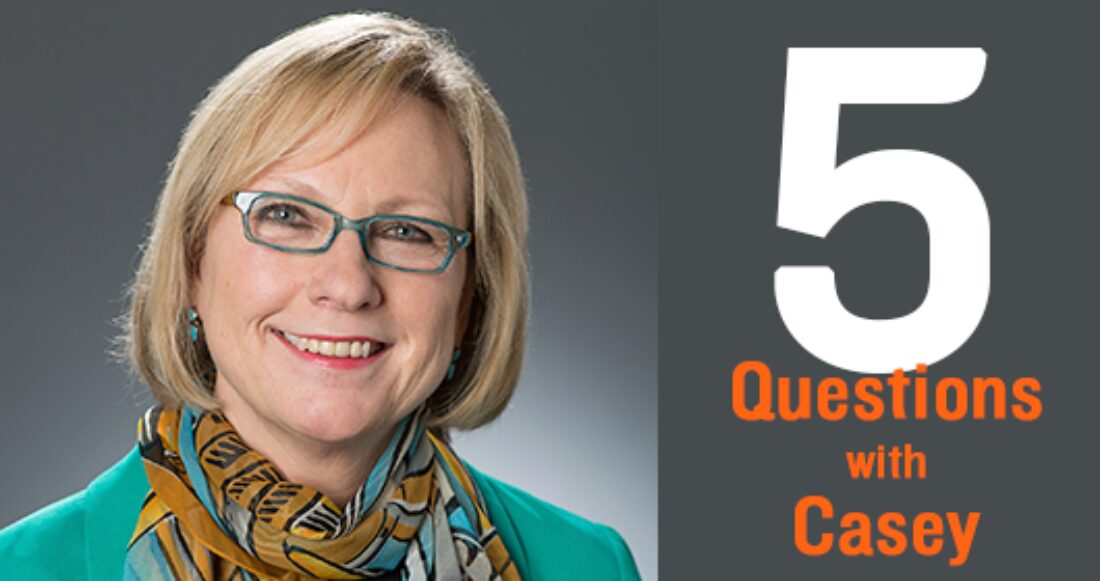Five Questions with Casey: Cynthia Weaver on Bringing Evidence2Success to Alabama

As a senior associate with Casey’s Evidence-Based Practice Team, Cynthia Weaver works to expand the use of programs backed by scientific evidence when serving vulnerable kids and families.
Before working at Casey, Weaver served as an assistant professor at the University of Southern Mississippi School of Social Work. She also founded and ran a consulting company that developed and evaluated services for children and youth facing a variety of challenges. Weaver earned a doctorate and master’s degree in social work from the University of Alabama and a bachelor’s degree in English from the University of Alabama.
In this Five Questions edition, Weaver tells how Casey’s Evidence2Success framework is empowering communities — and the state of Alabama — to help kids and families succeed.
Q1. How do communities use Evidence2Success to select the right strategies and programs for helping kids and families succeed?
Youth in sixth, eighth, tenth and twelfth grades in Evidence2Success communities complete well-being surveys every two years. These surveys help sites determine what risks youth face, the protective factors that can buffer these risks and which youth well-being outcomes to target for improvement. A web-based registry, called Blueprints for Healthy Youth Development, guides Evidence2Success communities in identifying evidence-based programs that best align with their youth well-being priorities. And then Casey partners with these communities to tailor and implement their chosen programs and ensure that they are effectively addressing each specified need.
Q2. Why did Casey choose Alabama as its next Evidence2Success location?
Casey was looking to implement our Evidence2Success framework at the state level, and Alabama was attractive for several reasons. First, the state requires every county to have a children’s policy council that assesses unmet needs and recommends better ways to serve children, youth and families. These councils have a shared mission and multi-sector membership that are well suited for implementing the Evidence2Success framework. Next, the Alabama Department of Youth Services (DYS) was an early public system champion for this initiative. Leadership at DYS understand the importance of effective prevention to keep children from entering public systems in the first place. And, as an added bonus, DYS already had a positive experience with Casey’s Juvenile Detention Alternatives Initiative (JDAI), which resulted in cost savings and greater investments in community-based youth programs.
Q3. Providence, Rhode Island, became the first city to partner with Casey on Evidence2Success. How will implementation be different in Mobile and Selma, where the framework is being piloted in Alabama?
The five core elements of the program will not change. These include: 1) local governance through a community board that includes representation from residents of high-adversity neighborhoods; 2) using the Youth Experience Survey to prioritize youth well-being outcomes: 3) public system fund-mapping to realign a small percentage of their budget to sustain prevention programs over the long-term; and 5) using performance measures to assess change. Residents will help select proven prevention programs and practices in an effort to move the needle on priority youth well-being outcomes. These community voices will undoubtedly shape their site’s work in unique ways.
Q4. As Evidence2Success expands beyond Mobile and Selma to a long-term statewide effort, how will implementation differ?
Communities administer the youth survey locally and residents and stakeholders use this data to set local priority youth well-being outcomes. As a result, local strategic planning will always drive the implementation of Evidence2Success. At the state level, we will focus on encouraging public systems to come together around a common language for prevention and supporting the fund-mapping process of local public systems participating in Evidence2Success. These state-level actions will have a common goal: to support effective and sustainable prevention programs at the local level.
Q5. Who are some key partners that Casey is working with in Mobile and Selma?
In Mobile, the Mobile Area Education Foundation has a long history of leveraging discretionary dollars to improve academic outcomes. They understand the connection between achieving academic indicators, such as third-grade reading levels and high school graduation, and underlying social and emotional factors that affect educational achievement. The Mobile County Public School System, Mobile County Health Department, the Juvenile Court of Mobile County and the Mobile Public Housing Authority have also been strong public system supporters of Evidence2Success in Mobile.
In Selma, the lead organization is the Dallas County Children’s Policy Council, which includes the directors of public child welfare, behavioral health and public health as well as the school superintendent and law enforcement officials. District Court Judge Robert Armstrong III, who championed major juvenile justice reforms through JDAI, chairs this council. Judge Armstrong is an early and enthusiastic supporter of Evidence2Success and the importance of prevention to avoid unnecessary public system involvement.






